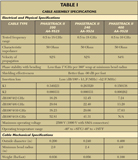Phase stability with respect to temperature has a direct impact on system performance and is therefore an important characteristic for high frequency components and subassemblies. Enhanced phase tracking with temperature translates into lower residual noise and reduced system uncertainties. Cable assemblies interconnecting critical high frequency signal paths will also significantly contribute to the phase characteristics of the entire system. Many conventional cables utilizing polytetrofluorethelene (PTFE) dielectric materials demonstrate an acute phase gradient versus temperature. In turn, this will adversely impact system performance such as the minimum discernable signal level, jamming and clutter resistance, and ultimately system range. A newly engineered dielectric material called TF5™ produced by Times Microwave Systems and used in its PhaseTrack II flexible coaxial cables offers greatly improved phase characteristics over temperature, essentially eliminating the sharp phase gradient associated with cables using PTFE or other dielectric materials.
High performance cables are used as interconnects for phase sensitive microwave transmitters, receivers and antennas on airframes, missiles, ships and ground-based communication systems. Test and measurement applications also require cables with high phase stability in order to reduce temperature-related drift, which leads to measurement inaccuracies and the need for frequent re-calibration. This is especially true for field testing of aircraft, ground-based radar or cellular infrastructure where outdoor temperatures fluctuate. Given the importance of maintaining phase stability over temperature (as well as low loss, weight and cost), cable manufacturers are continually improving the quality of these seemingly simple structures through the use of new materials and innovative mechanical design.

Figure 1 Typical coaxial cable assembly construction.
A typical microwave coaxial cable is a composite structure that consists of metal conductors separated by a polymer dielectric. The entire assembly is encapsulated with a polymer jacket, as shown in Figure 1. The behaviour of these materials with temperature and their interactions with one another will affect the overall phase versus temperature response of the assembly. At a constant frequency, the principle variables that will affect the electrical length (and thus the insertion phase) are the physical length and the net dielectric constant of the propagation material. Many high performance coaxial cables use PTFE or expanded PTFE as the dielectric insulator. This material undergoes dimensional changes, expanding (and becoming less dense) with increasing temperature. The result is a decrease in the effective dielectric constant that increases the velocity of propagation and results in a reduced electrical length. In addition, at approximately 19°C there is a dramatic change in the dielectric dimensions due to a change in the crystal structure. This abrupt change in the physical dimensions translates into a sharp gradient in the phase versus temperature response of PTFE cables.

While the dielectric constant decreases with temperature, thereby reducing the electrical length of the cable, the metal conductors in the coax cable are expanding and thus the physical length (and thereby the electrical length) is actually increasing. The inverse relationship between increased electrical length due to conductor expansion and decreased electrical length due to a lower dielectric constant is beneficial in reducing the overall change in phase over temperature. Many cable manufacturers have utilized this inverse relationship to minimize phase change versus temperature through their choice of materials and mechanical design. However, the abrupt change still impacts cable phase stability over this widely used temperature range. The TF5 material from Times Microwave does not exhibit this change in dielectric constant and therefore maintains a relatively flat phase variation versus temperature.

Figure 2 Phase change vs. temperature for various cable assemblies.
The phase change (in ppm) versus temperature for the PhaseTrack II cables, shown in Figure 2, demonstrates the flat phase response relative to cables with various PTFE dielectric materials. Having the best absolute phase change characteristics in a cable allows system engineers to reduce frequent phase calibrations, simplify system error correction software, and increase system availability and accuracy. By utilizing the most phase stable dielectric material available, PhaseTrack II flexible coaxial cables can significantly improve performance in phase sensitive systems. Typical electrical and physical specifications for the PhaseTrack II cable assemblies are shown in Table 1. PhaseTrack II cable assemblies are designed to operate up to 18 GHz for applications requiring minimal change of electrical length over a dynamic temperature range combined with low insertion loss and weight. Such applications include AESA Radar, ICBM Tracking Radar, interferometry-based broadband ELINT Systems, Phased Array and Synthetic Aperture Radar.
Times Microwave Systems
Wallingford, CT
(800) 867-2629
www.timesmicrowave.com
RS No. 304
